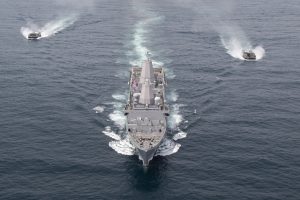[ad_1]
Asia Defense | Security
The exercise will also see all four Quad nations participating amid further deepening of bilateral defense ties within the grouping.

Two landing craft air cushions fly behind USS Somerset in the Pacific Ocean during a photo exercise, November 23, 2018.
Credit: Flickr/Official U.S. Navy Page
The France-organized multination three-day Le Pérouse naval exercise commenced in the Bay of Bengal on April 5, with the participation of the Quad nations in this year’s edition. According to an Indian Ministry of Defense statement, the Indian Navy is fielding the Shivalik-class stealth frigate INS Satpura along with its integral helicopter and anti-submarine warfare stealth corvette INS Kiltan, besides P8I maritime patrol aircraft.
“The exercise La Pérouse, led by French Navy, has participation by FN [French Navy] Ships Tonnerre, an amphibious assault ship and frigate Surcouf. United States Navy is represented in the exercise by amphibious transport dock ship Somerset. Her Majesty’s Australian Ships (HMAS) Anzac, a frigate and tanker Sirius have been deployed by RAN [Royal Australian Navy] for participation in the exercise while Japan Maritime Self Defence Ship (JMSDF) is represented by the destroyer Akebono,” the statement noted.
“Exercise La Pérouse will witness complex and advanced naval operations including surface warfare, anti-air warfare and air defense exercises, weapon firing exercises, cross deck flying operations, tactical maneuvers and seamanship evolutions such as replenishment at sea,” it added.
Australian Minister for Defense Peter Dutton was quoted as saying, “Exercise La Perouse will also demonstrate the complementary capability of our partner nations and highlight our shared commitment to a stable and secure Indo-Pacific.” Two hundred and sixty Royal Australian Navy personnel will be taking part in the exercise.
Last year’s La Pérouse exercise in the Bay of Bengal brought together the Australian, Japanese, and U.S. navies alongside the French. The 2020 edition saw the participation of France’s sole nuclear-powered aircraft carrier, Charles de Gaulle, while Japan fielded its helicopter carrier JS Izumo. Since the release of an Indo-Pacific strategy in 2019, Paris has sought to play a much more robust role in the mega-region’s security, with French President Emmanuel Macron front and centering Australian and Indian roles in the incipient regional security architecture.
The addition of India to the list of countries participating in the exercise has led many (especially in the Indian media) to dub it as a “Quad Plus” exercise. It is, however, important to note that while such an impression may be understandable, France has shown no interest so far in joining the Quad. It also needs to be kept in mind that the 2020 Malabar exercise – which saw the participation of Australia for the first time in 13 years in the India-hosted India-Japan-U.S. maritime exercises – did not take place within the aegis of the Quadrilateral Security Dialogue.
That said, bilateral security ties within the Quad continue to deepen. On March 28 and 29, the United States Navy’s Theodore Roosevelt Carrier Strike Group had exercised with the Indian navy and air force in the Indian Ocean. According to a U.S. 7th Fleet statement on the occasion, “The exercise focused on complex operations such as anti-submarine warfare, joint air operations, and command and control (C2) integration.” “It demonstrated the capacity of the two nations to operate together to advance a common vision of Indo-Pacific, ensuring peace and stability,” the statement also noted.
On March 29, JS Kongo and the U.S 7th Fleet flag ship USS Blue Ridge exercised together to enhance interoperability between the U.S. navy and JMSDF. A U.S. 7th Fleet statement quoted Captain Fujisaki Masaru, commanding officer of JS Kongo, as saying of the exercise: “I am convinced that we can improve deterrence and interoperability in response to possible contingencies through regular bilateral exercises such as the one we conducted.”
[ad_2]
Source link